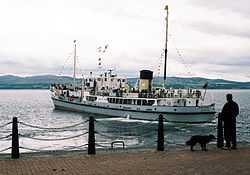SS Shieldhall
 | |
| Career | |
|---|---|
| Name: | Shieldhall |
| Owner: | The Solent Steam Packet Ltd |
| Port of registry: | www.ss-shieldhall.co.uk |
| Builder: | Lobnitz & Co., Renfrew, Scotland |
| Laid down: | October 1954 |
| Launched: | July 1955 |
| In service: | October 1955 |
| Identification: | IMO number: 5322752 |
| Status: | In service |
| General characteristics | |
| Tonnage: | 1,792 GT[1] |
| Length: | 81.69 m (268 ft 0 in) |
| Beam: | 13.56 m (44 ft 6 in) |
| Draught: | 3.2 m (10 ft 6 in) |
SS Shieldhall is a preserved steamship that operates from Southampton. She spent her working life as one of the "Clyde sludge boats", making regular trips from Shieldhall in Glasgow, Scotland, down the River Clyde and Firth of Clyde past the Isle of Arran, to dump treated sewage sludge at sea. These steamships had a tradition, dating back to the First World War, of taking organised parties of passengers on their trips during the summer. SS Shieldhall has been preserved and the accommodation is again being put to good use for cruises.
History

The 1,972-ton Shieldhall was laid down in October 1954, built by Lobnitz & Co. of Renfrew who also constructed the two triple expansion steam engines which are set vertically in a similar way to the much larger engines on the RMS Titanic. By the 1950s Lobnitz usually built its engines with enclosed crankcases but the Shieldhall was deliberately fitted with traditional open-crank engines. Glasgow Corporation had long allowed day-trippers access to the engine room of its ships while at sea and the older-style engines allowed passengers to see the workings of the engines in operation.
She was built on classic lines with a traditional wheelhouse of riveted and welded construction, a straight stem and a cruiser stern. Her length is 268 feet (82 m) and breadth 44 feet 7 inches (13.6 m). Accommodation was provided for 80 passengers. She entered service in October 1955 and was operated by Glasgow Corporation to transport treated sewage sludge down the Clyde to be dumped at sea.
In 1976 after 21 years of service on the Clyde, Shieldhall was laid up, and in the following year was bought by the Southern Water Authority to carry sludge from Southampton, England, to an area south of the Isle of Wight.
Preservation

Due to rising fuel prices she was withdrawn from service in 1985, then was taken over by a preservation society, The Solent Steam Packet Limited, which operates as a charity. All work associated with the Society and Shieldhall is carried out by unpaid volunteers. The remaining Glasgow sludge boats kept going into the 1990s, when changing environmental standards led to new ways of treating the sludge.
With a great deal of work by these volunteers she has been restored to sea-going condition, and now listed as part of the National Historic Fleet, the Shieldhall is now a frequent sight around the Solent running excursions, crewed by volunteers. She has been to the Netherlands for the Dordrecht Steam Festival and has been at International Festivals of the Sea at Bristol and Portsmouth. Passengers are encouraged to visit the bridge and see the engine room, getting an understanding of the days of steam.

In July 2005 the Shieldhall made a return visit to the Clyde, taking part in the River Festival in Glasgow, and berthing at Custom House Quay, Greenock. She made a number of excursions, taking passengers on cruises from Greenock on her old route down the Clyde to Arran.
In 2012, to mark the centenary of the sinking of the Titanic, the Shieldhall was repainted in the same colour scheme as the liner.
A £1.4 million grant from the Heritage Lottery Fund (HLF) will enable charity The Solent Steam Packet Limited (TSSP) to secure the future of the largest steamship of her type in Europe. The HLF award, announced in April 2013, is for a three-year project Saving Shieldhall – Learning through Conservation in Action. Essential hull works to meet modern regulations, improved passenger facilities and state-of-the art interpretation will enable the volunteers who maintain and operate this unique vessel to preserve and deliver the living experience of a steamship at work for future generations.
Shieldhall” is unique as a time capsule providing a working example of steamship machinery both above and below deck, typical of the cargo and passenger ships that plied the oceans of the world from the 1870s until the mid 1960s, by which time they were all but extinct.
The ship is of special interest as she is built on the classical lines of a 1920s steamer with a traditional wheelhouse; the hull is of riveted and welded construction and this unusual feature is representative of the transitional phase in British shipbuilding when welding took over from riveted practice. The hull has a slightly raked bow and cruiser stern. The teak decks and emergency steering position aft add to the classic effect. Shieldhall was effectively obsolete mechanically at the time of her launch having steam machinery representative of the late 19th century at a time when the diesel engine was coming into its own.
Now believed to be the largest working steam ship in Northern Europe, she is owned and operated entirely by voluntary effort.
References
External links
| Wikimedia Commons has media related to SS Shieldhall. |
| ||||||||||||||||||||||||||||||||||||||